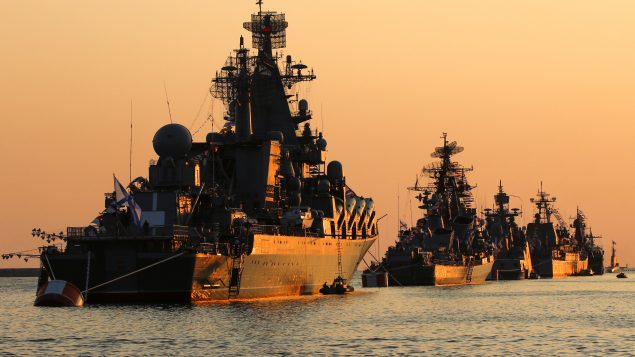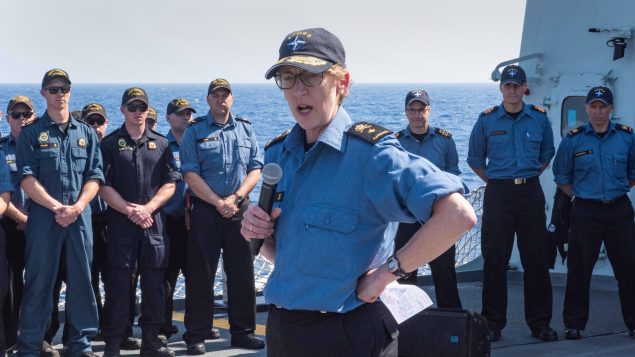A female Royal Canadian Navy officer has made NATO maritime history by becoming the first woman to command a multinational naval task force in one of the alliance’s most sensitive areas of maritime operations.
Commodore Josée Kurtz has assumed the command of Standing NATO Maritime Group Two (SNMG2), one of the alliance’s four maritime groups, whose primary area of operations extends to the Mediterranean and the Black Sea.
The eastern Mediterranean off the coast of Syria and the Black Sea, off the coast of Ukraine and Russian-annexed Crimea, are some of the alliance’s most complex areas of maritime operations where NATO warships come into close proximity with the Russian navy in what are essentially conflict zones.
“These four groups provide capability, show presence and demonstrate NATO alliance solidarity and strength in various theatres of operations,” Kurtz said in a phone interview with Radio Canada International on board her flagship, Canadian frigate HMCS Halifax, off the coast of northern Spain.
(click to listen to the full interview with Commodore Josée Kurtz)
ListenBut these groups can be fairly mobile, Kurtz said, pointing out that HMCS Halifax is presently off the coast of Spain heading to Portugal before making their way back to the Mediterranean and the Black Sea and then back to the Atlantic later this year.
“We can be supplementing other standing groups in other areas if that’s where the capability is required,” she said. “It speaks to the agility and the flexibility of those standing groups.”
Exercising with allies and partners

Members of Standing NATO Maritime Group 2, and naval vessels from NATO partners Bulgaria, Romania and Ukraine, sail in formation while conducting Maritime Security Awareness (MSA) in the Black Sea during Exercise SEA BREEZE 2019, on July 11, 2019. (MCpl Manuela Berger/Formation Imaging Services Halifax)
Kurtz assumed command of SNMG2 during a ceremony in Souda Bay, Greece, on June 15, while Canadian frigate HMCS Toronto, which became her first flagship, had already been at sea for five months.
Shortly after, the NATO task force led by the Canadian frigate sailed the Black Sea, with British destroyer HMS Duncan, Romanian frigate ROS Regele Ferdinand, and Turkish frigate TCG Turgutreis.
NATO has three allies – Turkey, Bulgaria and Romania – and two partners – Ukraine and Georgia that share the Black Sea with Russia, Kurtz said.
“It makes sense that we show a presence in that area same as we do in other areas where we have NATO allies,” Kurtz said.
The task force participated in two exercises in the Black Sea, she said.
The first one was a joint Ukraine-U.S. exercise off the coast of Ukraine dubbed Sea Breeze 19.
The Canadian frigate sailed to the Ukrainian port city of Odessa to take part in that exercise, Kurtz said.

Leading Seaman Lyra Michelle Mazerolle a Steward onboard HMCS Halifax participates in a boarding party training exercise during Operation REASSURANCE, in the Atlantic Ocean on July 21, 2019. (Cpl. Braden Trudeau/Formation Imaging Services)
Following the conclusion of that exercise, SNMG2 headed southwest to Bulgaria to participate in the Bulgarian-led exercise Breeze 19, Kurtz said.
“By participating in those two exercises both with programs in port and a program at sea, by the same token we were able to demonstrate a significant NATO presence in the Black Sea area,” she said.
Throughout all that time, the NATO force was shadowed by the Russian navy, Kurtz said.
“From a NATO perspective we exercised freedom of navigation, conducted our exercises in the international waters of the Black Sea and we also conducted some exercise serials and activities within the territorial waters of our allies who have had invited us to participate in those exercises,” Kurtz said.
‘Active and very obvious’

A view shows Russian warships on sunset ahead of the Navy Day parade in the Black Sea port of Sevastopol, Crimea July 27, 2019. (Alexey Pavlishak/REUTERS)
The Russians were very “active and very obvious” in making their presence known to the NATO warships, she said.
“Most interactions I would qualify as generally safe and professional, according to the law of the sea and the practice of good seamanship,” Kurtz said. “They were quite assertive at times, they were not in some instances hesitating, perhaps, in closing the usual distances that they had been maintaining up until then.”
However, even then the Russian and NATO warships remained several miles apart, she added.
Last week, HMCS Halifax took over the responsibility of the flagship in a ceremony at naval station Rota, Spain, on July 26.
Kurtz will remain at the command of SNMG2 until the end of the year.







For reasons beyond our control, and for an undetermined period of time, our comment section is now closed. However, our social networks remain open to your contributions.